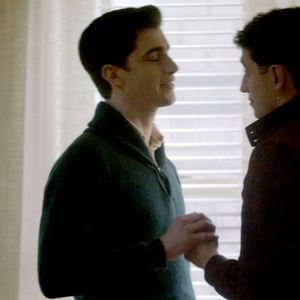CONTACTStaffCAREER OPPORTUNITIESADVERTISE WITH USPRIVACY POLICYPRIVACY PREFERENCESTERMS OF USELEGAL NOTICE
© 2024 Pride Publishing Inc.
All Rights reserved
All Rights reserved
By continuing to use our site, you agree to our Private Policy and Terms of Use.
A world premiere recording of a major new work by one of America's best known openly gay composers is certainly nothing to ignore, in fact to do so would seem almost criminal. While John Corigliano's 3rd symphony, "Circus Maximus" may not be the best thing he has ever penned (my vote would be for his opera The Ghosts of Versailles ,) it is worthy of attention, and well worth hearing, even for those who are uninitiated in the world of contemporary classical music.
Corigliano, who celebrated his 70th birthday last year (and still looks as young and attractive as he's ever looked), has been a major figure in the world of contemporary music for over forty years, and the music seems to flow as easily and effortlessly from his pen as champagne from a crystal decanter. His style has always been varied and hard to define - in fact it would be almost impossible to pinpoint what the distinctive "Corigliano Style" is. The publication of his 1st Symphony in 1991, dedicated to and inspired by many of his friends who has succumbed to the AIDS virus, could be seen as an official "coming out" of sorts; since then he has been an active member of the gay community and has been profiled by and interviewed in many gay publications, including The Advocate . To a wider public, he's probably best known as the composer of the Oscar winning score for the popular film The Red Violin .
His Second Symphony, published in 2001, earned him the Pulitzer, which makes it a tough act to follow indeed. His third, subtitled "Circus Maximus", followed in 2004, and receives its world premiere recording here. In a sense, it is a bit of a let-down after the intense and grandiose second, but it still has moments of great beauty and originality.
Much shorter than his first two symphonies, the third is scored only for winds, brass and percussion - there are no strings in this work at all. This gives the symphony a definitively brash and peculiar sound, which is very much in keeping with its theme. Corigliano calls the work "Circus Maximus", but it is not really an "historic" depiction in sound of what the ancient Roman entertainment arena was like. In actuality, the work explores the aggressively violent, manic and schizophrenic world of our own contemporary tastes in entertainment - from reality TV to cable, and contrasts them with the very similar Roman amphitheatre.
The most startlingly original aspect of the work is how the orchestra is laid out. The instruments are not placed in the hall in the traditional way - in fact, the layout mimics that of the Roman Circus Maximus, complete with a separate marching band that makes its way from the back of the hall to the stage. A complete diagram is provided in the CD booklet - it makes for a fascinating study.
The work is organized into eight relatively short movements, all played without pause. The 1st, called "Introitus" (Latin - "Introduction") begins, as one would expect, with a fanfare which becomes rapidly more and more dissonant - even violent. A trombone solo accompanied by wood blocks introduces a rather sinister episode, which is followed by the original fanfare. The second movement, "Screen/Siren" is dominated by a seductive melody played by saxophone quartet, sometimes undulating passages in the winds interject giving a sense of languorous movement. This leads abruptly to "Channel Surfing" - which sounds exactly how you might think a musical depiction of this common activity might sound. Various themes, from a romantic TV Western-like melody on horns, to a wild Mambo, to a fantastic "Sci-Fi" wind theme, take their turns, on-and-off, back and forth. Our contemporary dwindling attention spans have never been captured so precisely. The movement dies out with wailing brass.
The mood of "Night Music I" could not be more different - tranquil, beautiful, mysterious, and just a trifle ominous. Is this the Circus Maximus at night, after the crowds have gone home? The weird animal calls depicted by the wind instruments seem to indicate this. The serenity of "Night Music I" is immediately contrasted with "Night Music II", a portrait of contemporary city nightlife, brash, jazzy and sleazy. This is followed by the work's climax - "Circus Maximus" in which all the previous themes conjoin into an odd melange that miraculously never descends into cacophony. This is where the marching band makes its entrance - very reminiscent of the music of Charles Ives.
A beautiful "Prayer" rounds off the work - is this a prayer for humanity or for our current civilization? A lovely theme grows into something truly majestic and noble - followed by a coda "Veritas" ("truth"), which brings back the opening fanfare and ends with a (literal) gunshot.
The "filler" on the disc is Corigliano's orchestration of an early four-hand piano piece, "Gazebo Dances" (1972), and the mood is very dissimilar from the more recent work. This is a light set of very endearing dance pieces, and they do refresh the palette a bit after the heavier symphony. The orchestration is charming - reminding the listener a bit of Leonard Bernstein - not surprising, as Corigliano's father was concertmaster of the NY Philharmonic under Bernstein for many years.
All-in-all, "Circus Maximus" shows Corigliano in a more playful mood than he was in his earlier two symphonies, which may make the third appear more lightweight than it actually is. In a sense it kind of takes its place in Corigliano's output that Beethoven's lighter 4th or 8th symphonies do in his and this is no mean comparison. The University of Texas Wind Ensemble do the work proud, but as there is no other recording with which to compare it, that's about as much as can be said on that subject. The recorded sound is fine. The booklet is a bit skimpy, but the notes are written by the composer himself, and the aforementioned diagram of the orchestral seating arrangement very helpful indeed. This is most definitely worth listening to, and at the very reasonable Naxos price, should be sampled by anyone with an interest in modern music.
Want more breaking equality news & trending entertainment stories?
Check out our NEW 24/7 streaming service: the Advocate Channel!
Download the Advocate Channel App for your mobile phone and your favorite streaming device!
From our Sponsors
Most Popular
Here Are Our 2024 Election Predictions. Will They Come True?
November 07 2023 1:46 PM
Meet all 37 of the queer women in this season's WNBA
April 17 2024 11:24 AM
17 Celebs Who Are Out & Proud of Their Trans & Nonbinary Kids
November 30 2023 10:41 AM
Here Are the 15 Most LGBTQ-Friendly Cities in the U.S.
November 01 2023 5:09 PM
Which State Is the Queerest? These Are the States With the Most LGBTQ+ People
December 11 2023 10:00 AM
These 27 Senate Hearing Room Gay Sex Jokes Are Truly Exquisite
December 17 2023 3:33 PM
10 Cheeky and Homoerotic Photos From Bob Mizer's Nude Films
November 18 2023 10:05 PM
42 Flaming Hot Photos From 2024's Australian Firefighters Calendar
November 10 2023 6:08 PM
These Are the 5 States With the Smallest Percentage of LGBTQ+ People
December 13 2023 9:15 AM
Here are the 15 gayest travel destinations in the world: report
March 26 2024 9:23 AM
Watch Now: Advocate Channel
Trending Stories & News
For more news and videos on advocatechannel.com, click here.
Trending Stories & News
For more news and videos on advocatechannel.com, click here.
Latest Stories
Tristan Snell, who brought down Trump University, sees conviction in hush money case
April 22 2024 7:36 PM
Joe Biden admin marks Earth Day with major environmental initiatives
April 22 2024 4:18 PM
Texas Gov. Greg Abbott: 'We want to end' trans and gender nonconforming teachers
April 22 2024 4:13 PM
Nonbinary 17-year-old killed two years after being reported missing
April 22 2024 3:46 PM

Pride
Yahoo FeedIndulge in luxury and sensuality with The Pride Store’s Taurus gift guide
April 22 2024 11:46 AM
The gay man leading the Earth Day Initiative offers hope for the future
April 22 2024 9:00 AM
Pattie Gonia takes drag and fierceness to Capitol Hill to voice environmental concerns
April 22 2024 8:23 AM
Jodie Foster leaves her mark in cement at L.A.'s Chinese Theatre
April 22 2024 7:55 AM
Climate change has a bigger impact on LGBTQ+ couples than straight couples. Here's how
April 22 2024 7:42 AM
Iraq postpones vote on bill punishing gay sex with death
April 20 2024 1:31 PM
Russian poetry contest bans entries from transgender poets
April 20 2024 1:25 PM
Here's who won 'RuPaul's Drag Race' season 16
April 20 2024 1:01 PM
The Tip Off: A beginners guide to the WNBA
April 20 2024 11:06 AM
John Fetterman challenges Pa. school board’s cancellation of talk by gay actor
April 19 2024 2:39 PM

















































































